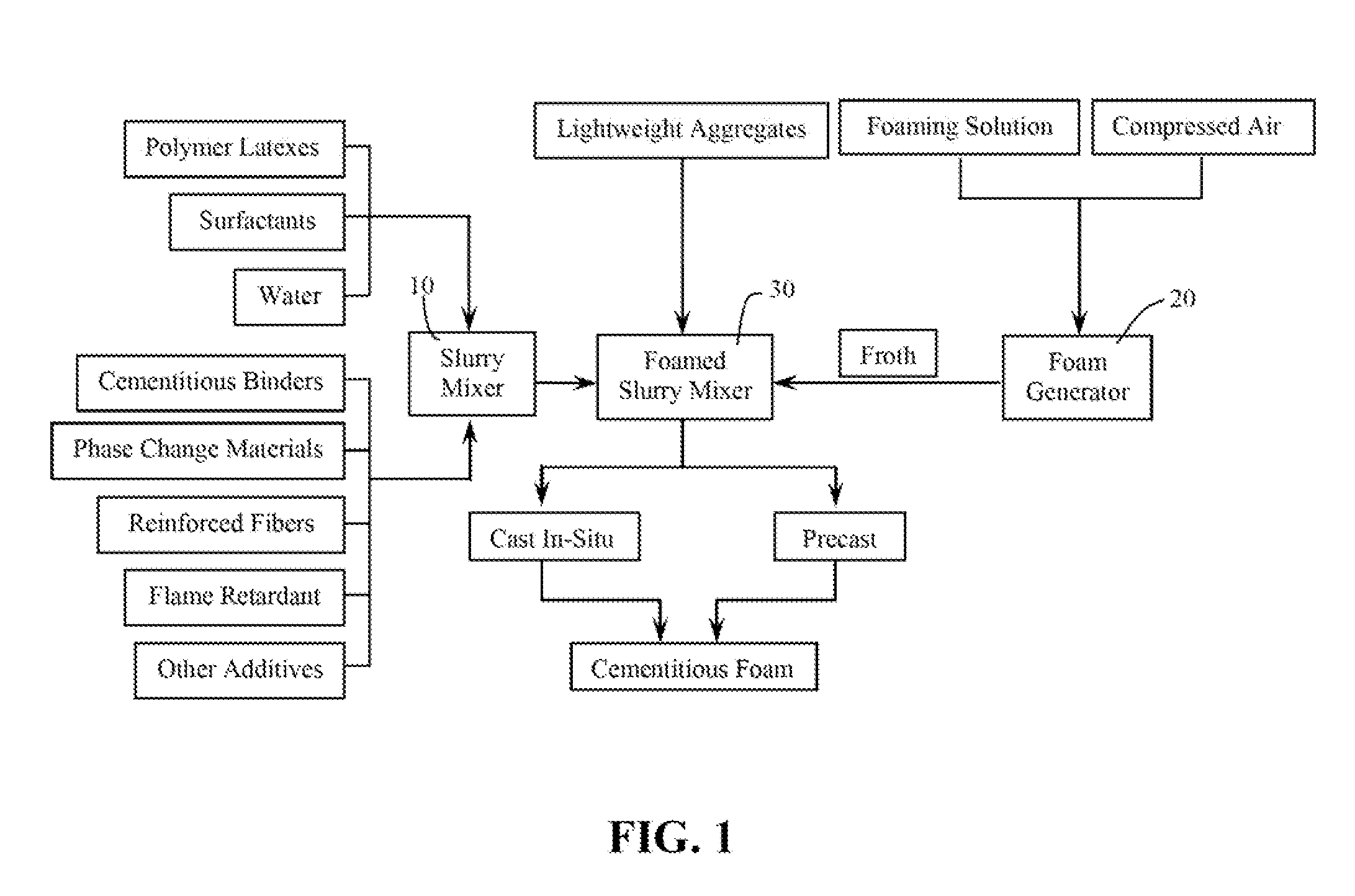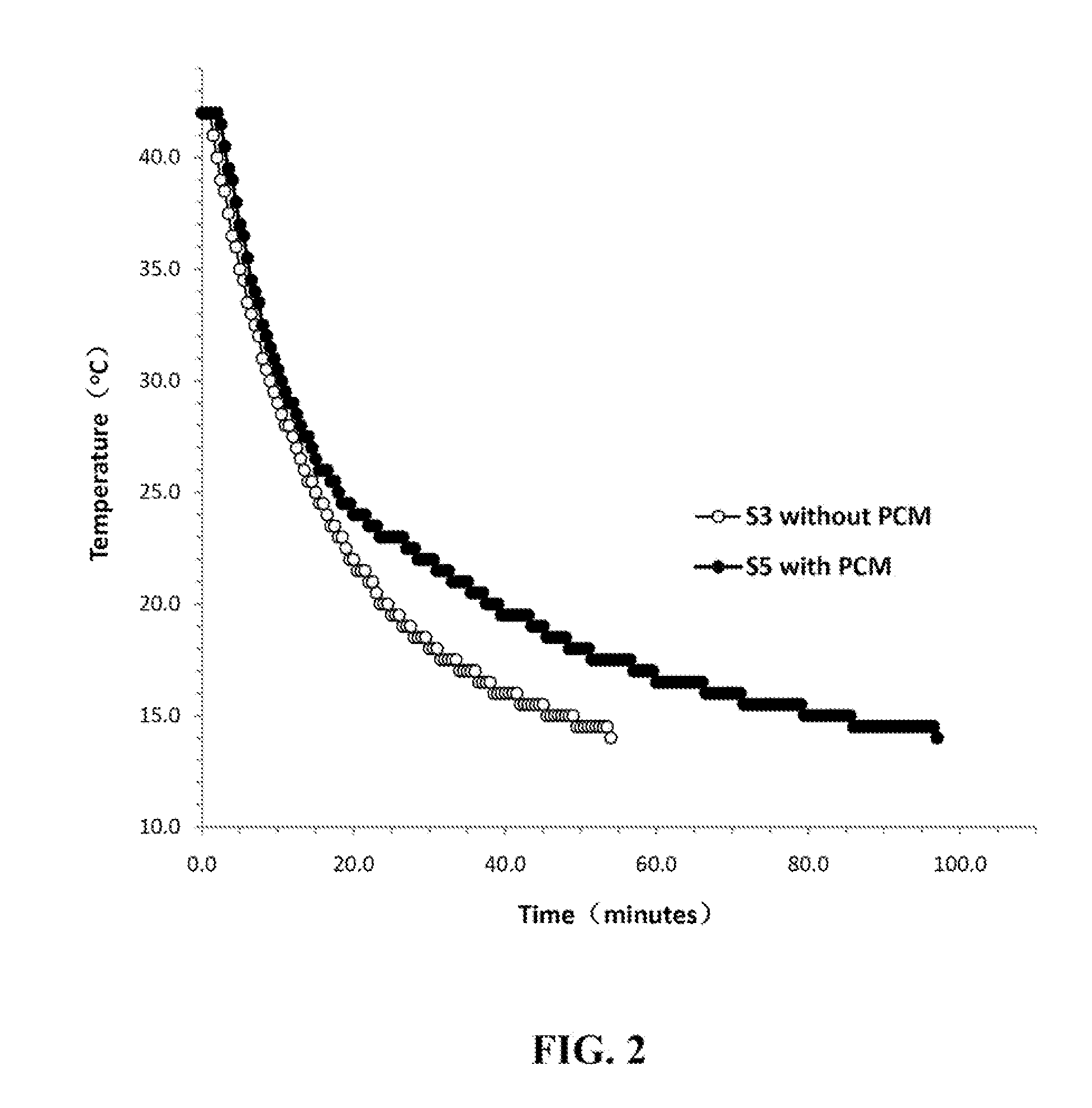Fireproof insulating cementitious foam comprising phase change materials
a phase change material and cementitious foam technology, applied in the field of fireproofing and thermal insulation materials, can solve the problems of difficult to retain fasteners, plastic foams undergo repaid thermal degradation and decomposition, limited fire resistance, etc., and achieve excellent fire resistance, good thermal insulation property, and high temperature resistance
- Summary
- Abstract
- Description
- Claims
- Application Information
AI Technical Summary
Benefits of technology
Problems solved by technology
Method used
Image
Examples
example 1
Two foaming solutions were prepared according to formulations listed in Table 1, and then they were sent to the foam generator. After a stable froth flow was created, foam samples were collected for foam density verification. The results are also given in Table 1.
TABLE IWeight %ComponentFoam 1Foam 2Alkylpolyglycol ether(1)0.2—Sodium phenyl sulfonate—0.3Acrylic latex(2)0.10.06Water99.799.64Foam density, pcf (kg / m3)5 (80)3 (48)(1)Surfonice air entraining agent from Huntsman(2)Ucar Latex 163S from Dow Chemical
example 2
A series of sample compositions were prepared following formulas listed in Table 2 to demonstrate the effects of the phase change material on temperature holding and mechanical performance of the inventive materials.
TABLE 2Sample I.D., Weight %ComponentS 1S2S3S4S5S6Calcium sulfate hemihydrates 69.26640363632Portland cement, Type 1——26242422Fly ash———5—5Hydrated lime———1—1Micronal PCM(1)————66EPS foam beads222222Acrylic latex(2)—3.23.23.23.23.2Foam 2 (from Example 1)2.82.82.82.82.82.8Fiberglass(3)1.21.21.21.21.21.2Alcohol ethoxylate(4)0.10.10.10.10.10.1Magnesium hydroxide2.52.52.52.52.52.5Water reducer(5)0.20.20.20.20.20.2Water222222222222(1)Microencapsulated phase change material from BASF(2)Ucar Latex 163S from Dow Chemical, 58% solid content(3)chopped strand, 15 μm in diameter, 25 mm in length, from PPG Fiber Glass(4)Empilane ® K surfactant from Huntsman(5)sodium lignosulphonate from Lignotech
The resulting slurry mixtures were cast into molds to make 1″×12″×30″ (25×305×762 mm) cem...
example 3
A number of 2″×12″×12″ (50×305×305 mm) cementitious foam boards were prepared following the compositions listed in Table 2 from Example 2. The boards were removed from the molds after 4 hours and cured for 7 days at room temperature. Several 2″ (51 mm) cubic specimens were taken from each type of the sample boards for compressive tests according to ASTM C 109. Dry densities of the samples were measured after 14 days room temperature cure. Thermal conductivity of each sample was determined using a KD2-Pro thermal property analyzer manufactured by Decagon Devices, Pullman, Wash. Water resistance tests were conducted by immersing the 2″ cubic specimens in water for 1 hour, and then measuring weight gain, which is the increase in specimen weight before and after water immersion. Water absorption can be expressed in, terms of weight gain per unit surface area of a specimen. The results of property testing are summarized in Table 3.
TABLE 3Sample I.D.Property(1)S 1S2S3S4S5S6Dry density, pc...
PUM
| Property | Measurement | Unit |
|---|---|---|
| thermal conductivities | aaaaa | aaaaa |
| solid-liquid phase transition temperature | aaaaa | aaaaa |
| melting point | aaaaa | aaaaa |
Abstract
Description
Claims
Application Information
 Login to View More
Login to View More - R&D
- Intellectual Property
- Life Sciences
- Materials
- Tech Scout
- Unparalleled Data Quality
- Higher Quality Content
- 60% Fewer Hallucinations
Browse by: Latest US Patents, China's latest patents, Technical Efficacy Thesaurus, Application Domain, Technology Topic, Popular Technical Reports.
© 2025 PatSnap. All rights reserved.Legal|Privacy policy|Modern Slavery Act Transparency Statement|Sitemap|About US| Contact US: help@patsnap.com



